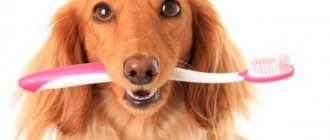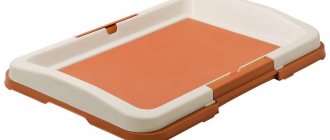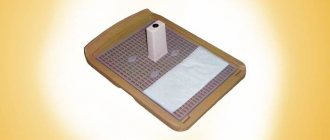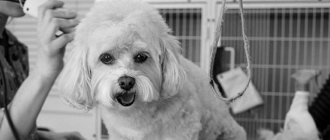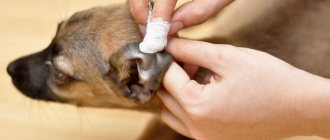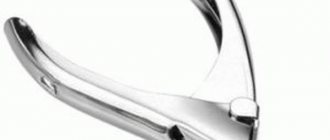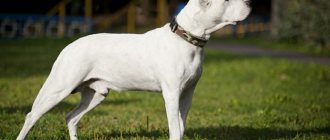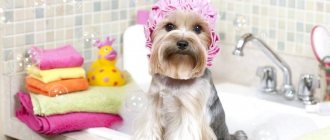Breeders have mixed feelings about toothpaste. Many believe that this is normal pampering and the pet cleans its teeth on its own using bones and hard snacks. Despite natural processes, using even the most ordinary toothpaste will protect your beloved dog from a huge number of diseases.
To fully answer whether toothpaste is needed or not, it is worth understanding this in detail.
What does daily oral hygiene do?
If you visit a veterinarian, then the doctor has probably already told you that there is toothpaste for dogs. It gets rid of the resulting unpleasant odor. This happens by destroying harmful bacteria. Thus, the product can be used for preventive purposes. Regular sanitation of the oral cavity will significantly reduce the risk of developing caries and plaque.
Toothpaste for dogs allows you to quickly and effectively remove food particles that are stuck between the teeth. However, it should be remembered that human compositions cannot be used for a four-legged friend under any circumstances. Even baby toothpaste often contains fluoride, which causes severe poisoning, convulsions, and tremors. And it is unlikely that you will be able to avoid swallowing the composition, especially if you have never performed this procedure before.
What can you use instead of pasta?
If you don’t have a special toothpaste on hand, you can use other products. Please note that you cannot use tooth powder or baking soda. Regular toothpaste is too aggressive for an animal, even for children.
For such purposes, you can use diluted hydrogen peroxide. Activated carbon, chlorhexidine, tomato paste. To do this, wrap the finger in a bandage, soak it in the product and clean the teeth.
Reasons for the problem
Stone plaques form in hard-to-reach places under unfavorable conditions and lack of hygiene. There are several factors that can cause tartar to appear on a dog’s teeth.
Incorrect selection of feed
The risk of plaque increases significantly if the pet is fed soft food. It does not contribute to prolonged friction of the jaw surfaces and self-cleaning of the teeth. Constantly feeding an animal canned food is the main mistake of modern breeders. It should be remembered that the dog’s teeth need active use. If you stop using the incisors, canines, and molars, the jaw will begin to deteriorate.
Dry food partly solves the problem, since solid particles clean off the initial plaque. But this does not mean at all that dogs consuming “drying” are protected from the formation of tartar.
Impaired metabolism
Excessive carbohydrate content in food leads to a weakening of the body's protective functions. You shouldn’t spoil your furry friend with “tasty food.” Experienced breeders know that sweets are contraindicated for animals - they contribute to the development of diabetes and oral problems. This is due to the accelerated proliferation of bacteria: plaque will appear faster and darken if the dog’s diet is not balanced.
High acidity of saliva
This indicator is individual: everything will depend on the breed, age, gender and other characteristics of the dog’s body. Acidic saliva is a favorable environment for some bacteria; it can become a factor in disrupting salt metabolism. Veterinarians believe that frequent hypothermia and insufficient physical activity can lead to such a deviation.
Late mouth care
Not only people should constantly brush their teeth; pets also need a similar procedure. Even if you feed your dog the highest quality products, over time he will develop deposits in any case. To avoid problems, you should periodically clean the mouth with veterinary paste and give the animal bones specially designed for this.
Irregular teeth structure
Predispositions to the formation of stones include pathological changes in the jaw, malocclusion, narrow interdental spaces, too dense or crooked teeth. All this leads not only to plaque, but also to digestive problems.
Of course, the stone itself does not pose an immediate threat to life. But against the background of enamel damage, diseases can develop, for example, gingivitis, periodontal disease, gastrointestinal disorders, and respiratory problems. And these problems can subsequently lead to the death of the pet.
Untreated tartar weakens the immune system, which inevitably leads to diseases of all kinds. Therefore, caring for a dog’s teeth should be perceived by the owner as an important part of keeping a pet.
Detection of the consequences of tartar and preventive measures
It often happens that when removing tartar, more serious “dental” problems emerge (for example, deep caries). It leads to the destruction of tooth enamel and demineralization of hard tissues of fangs and molars, and also affects the root and causes pulpitis. If the pet has impressive dimensions, then the dentist has the opportunity to fill the tooth. However, if the dog is small, this cannot be done.
Periodontitis in pets is an even more complex disease than caries. It is an irreversible inflammatory process that develops in the connective tissues connecting the tooth root with the alveoli. The insidiousness of periodontitis is that modern medicine has not found a method that could completely neutralize the pathological process. Therefore, preventive measures are of great importance, which include the following:
Mandatory teeth cleaning for dogs. It is important to brush your pet's teeth regularly using toothpaste, a toothbrush and a special brush to massage the gums. Before purchasing all this, you should consult with your dentist: he will help you make the best choice for your dog. If the pet is healthy, then the teeth cleaning procedure should be carried out once a week, if there are problems with the teeth - more often, as recommended by the doctor.
Balanced diet. All veterinarians in the world insist on the importance of proper nutrition for dogs: healthy food contributes to the health of the whole body. It is important to carefully consider the dog menu, completely eliminating flour and sweets. There is a myth that a dog needs to constantly chew on something, such as bones. In fact, this is a serious burden not only for teeth, but also for gums. You should not subject your oral apparatus to such a test, because there is a possibility of injuring tooth enamel. If you frequently give your dog bones, by the age of six he may lose almost all his teeth.
Choosing the composition
Today, a veterinary pharmacy will be able to offer you several options. Which one to choose is sometimes difficult to answer right away, so study the composition of the product. Toothpaste for dogs of small breeds, as well as large ones, should be gentle and safe. However, do not forget that each individual component can become a source of allergies. Let's look at the composition of dog pastes, so to speak, in cross-section, so that you can imagine why this or that substance is included in it.
The basis is water. Its function is to dissolve solid residues. This is especially true if your pet eats natural food. Glycerin is used to give the paste a unique texture, viscosity and density. Gum acts as a stabilizer; with its help, the paste maintains its consistency.
To prevent hardening, various substances are used, the safest of which is carrageenan. If it is indicated on the package, you can rest assured about the health of your pet. Usually the paste is sold in the usual white color, this is due to titanium dioxide.
Sorbitol gives the product a pleasant, sweet taste. This is a safe sweetener that does not burden the pancreas and does not cause excess weight gain. To give tooth enamel a flawless shine, abrasive particles are added to the composition, very often this is ordinary baking soda.
Which composition is safe for animals
Humans should not brush their teeth with toothpaste. After all, it cannot be swallowed, and it is impossible to explain this to a dog or cat. And the paste itself is tasteless, it stings the mucous membrane. Neither the cat nor the dog will definitely like it. The animal cannot rinse its mouth with water and spit the composition into the sink. Therefore, this composition is not suitable for a dog or cat. Moreover, such a paste is dangerous for them, because it contains xylitol and lauryl sulfate, which can be hazardous to the health of pets.
Special formulations are being developed for pets. This includes purified water, which dissolves solid particles. Titanium dioxide and sodium triphosphate remove bacterial plaque. Sodium bicarbonate whitens teeth; enzymes dissolve food debris between teeth.
In order for the paste to be stored for several months without losing its properties, preservatives are added to its composition: sodium benzoate and potassium sorbate. Sorbitol makes the product more pleasant to use. It also includes other flavorings: meat, liver, nuts, vanilla, milk, tomatoes.
It is good if the toothpaste contains natural additives, including parsley seeds, lavender, and tea tree oil. Purified clay makes toothpaste softer. It delicately cleanses the enamel of plaque without compromising the integrity of the enamel.
For the little ones
Today, many people choose decorative dog breeds: Chihuahuas, toy terriers and other kids are very convenient for apartment living. These dogs live quite a long time, about 20 years, but, unfortunately, they are susceptible to diseases of the oral cavity, in particular they suffer from the presence of tartar. To ensure that your pet remains able to eat normally, it is extremely important to start brushing his teeth with special toothpastes from a very young age. Veterinarians say that this procedure should be performed at least once a week, and it is better to reduce the interval to once every three days.
Top brands
Below are several brands of dog toothpastes that have the most positive reviews on dog owner forums.
Dental Fresh / Liquid toothbrush Dental Fresh
The liquid toothbrush actively fights halitosis and also has a slight whitening effect. Dental Fresh is available in the form of a mouth rinse and spray.
A teaspoon of rinse aid is diluted with 250-300 ml of drinking water.
Important! Some pets refuse to drink this water because of the small amount of menthol contained in the rinse.
Dental Fresh dog teeth spray is applied directly into your pet's mouth twice a day. A liquid toothbrush is used for a course of 4 weeks with breaks of 4 months.
Dental Fresh
Beaphar Dog A Dent
Beaphar Dog A Dent fights several dental problems at once:
- bacteria;
- pigmentation on teeth;
- stale breath.
This paste does not foam and is very economical to use.
8 in 1 DDS Dental Breath Tabs / Tablets for fresh breath
Representatives of some dog breeds can sometimes experience downright bad breath. A good alternative to toothpaste for such pets would be tablets for fresh breath. They do not cause allergic reactions and are completely harmless to the dog’s body.
Dental Breath Tabs should be given to your dog 2-3 times a day. By the end of the first day of treatment, dog owners note a significant reduction in the unpleasant odor from the animal’s mouth.
Important! Dental Breath Tabs is a remedy with a short-term effect, akin to the well-known human Orbit or Dirol.
Platinum
An excellent toothpaste for dogs against tartar is OralClean + Care from Platinum. In addition, this cleanser is effective against gum inflammation and bad breath.
OralClean + Care produces products that are absolutely harmless to the body of pets. It is completely safe to swallow when used.
Cliny
Gel for dogs for cleaning teeth Cliny with silver ions from the German company Neoterica helps to cope with a number of dental problems:
- plaque;
- halitosis;
- yellowness of teeth;
- inflammation of the gums;
- periodontal disease;
- stomatitis;
- tartar.
The above gel for cleaning teeth in dogs can be used without a brush, since the Cliny product disperses well with saliva.
Important! You should sanitize your dog's mouth with dental gel for dogs 2-3 times a week.
Tropiclean
Tropiclean dental gel for dogs perfectly removes tartar and also solves the problem of unpleasant odor from the mouth. Despite the sharp minty smell, Tropiclin completely lacks any taste.
Gel Tropiclean
When lifting your dog's upper lip, you should place just a couple of drops of cleaning agent on the far teeth. The manufacturers of Tropiclin advise not allowing your dog to eat or drink for half an hour before and after using the gel.
This dental cleaner can be used daily for a month, after that only once every 3 days to consolidate the results.
Le Artis - wet wipes
The hypoallergenic impregnating product is made specifically as a hygiene product for pets. Le Artis is a good remedy in the fight against the following dental ailments:
- caries;
- plaque;
- yellowness of enamel;
- halitosis;
- tartar.
Wet wipes can be used once a week if you cannot brush your teeth.
Hartz Dentist's Best Toothpaste / Vanilla and Mint Flavor
Advantages of Hartz paste:
- safe for dogs;
- effective in the fight against halitosis;
- has a good antibacterial effect;
- fights tartar.
It is enough to use once every three days.
How often should you brush your teeth?
Lack of regular oral cleaning brings a lot of trouble to a person and his smaller brothers. Often, teeth disfigured by stone growths cannot be treated. If they cannot be saved, there is only one way out - removal. And, it would seem, just recently the tooth was at a curable stage of caries, and today all that remains is to get rid of it in order to prevent further rotting of the deeper bones. Perhaps it will still be possible to overcome the old plaque, but this will only have to be done within the walls of a medical institution and under general anesthesia, which will bring additional hassle, waste of time and money.
At the same time, there is often no need to devote time to sanitizing the dog’s mouth. Two or three times throughout the year is enough. This will not cause any pain to the animal, and the need for anesthesia will also disappear by itself. The procedure itself lasts no more than half an hour, therefore, spending such a small amount of time, the owner will be rewarded with sparkling and healthy teeth of his pet.
First aid
If the first signs of stomatitis appear, you should immediately take the animal to the veterinarian! Sanitation of the oral cavity in dogs by a specialist in such a situation is simply necessary. If for any reason this cannot be done, then the following procedures must be carried out:
- Carry out a careful inspection of the mouth. Pay special attention to any foreign objects lodged in the gum or cheek, such as bone debris or wood chips. If possible, carefully remove the found object with tweezers. If a foreign object is stuck deeply and it is difficult to remove it yourself, it is better not to torture the animal and go to a specialist;
- Wipe damaged mucous membranes with chamomile decoction, furatsilin, a weak manganese solution (0.1%) or 0.05% chlorhexidine solution. You can fill the spray bottle and spray the dog’s mouth cavity. Try not to hit the epicenter of the wound because this can increase the pain. It is better to lightly spray the surface around it. Instead of a spray bottle, you can use a cotton swab, but this is more painful. After carrying out the above procedures, do not let your pet drink or eat for about an hour;
- Hide for a while all your pet’s toys that he gnawed, sucked, or chewed. If the wounds are severe, the dog itself will not want to play with them. In a milder form, these squeaks and taffy can cause a worsening of the condition;
- It is necessary to exclude any cold, hot and hard foods. You can temporarily change your diet and switch to a soup diet, soft porridges, twisted meat or boiled fish, chopped eggs, grated vegetables. The food should be slightly warm.
Anti-tartar toothpaste for dogs
Daily sanitation of the mouth cavity can serve as a prevention, but not a cure for this disease. Therefore, if you see that your pet’s fangs are covered with gray and yellow spots, and there is an unpleasant odor coming from the mouth, go to see a specialist. However, if you carry out this procedure regularly from puppyhood, you can prevent the development of the disease. Sodium hexametaphosphate, which is part of the paste, helps avoid the appearance of tartar. Sodium triphosphate allows you to quickly remove plaque, and essential oils have refreshing properties.
Special components (enzymes) included in the composition kill microbes, which is extremely important if the dog eats natural food (meat, liver). To prevent the pet from protesting against the hygiene procedure, various flavors are added to the product. They are often attractive to the animal because they resemble peanuts, liver or chicken. So you can choose what suits your pet's taste.
Symptoms of stomatitis in dogs
The disease begins with an inflammatory process of the mucous membrane. The dog begins to drool unusually and becomes thirsty. The dog begins to behave restlessly and may refuse to eat altogether. Upon visual examination, you can see redness and a grayish coating on the mucous membrane, as well as swelling. Saliva becomes viscous and may foam. The animal begins to wipe its face on the fur, behaves restlessly and sneezes. Signs of fever and depression may occur. Stomatitis, which appears as a result of the deposition of tartar, causes exposure of the roots of the teeth, bleeding gums, loosening of the teeth and an unpleasant odor from the mouth.
In certain breeds of dogs, the disease can cause ulcers in the mouth, with dead tissue at the edges. As a rule, this is typical for poodles (dwarf and small), as well as Pomeranians.
Shetland Sheepdog on a toothbrush
Pathogenesis
Precipitated mineral salts are gradually deposited on the yellowish soft coating. Initially loose, the formations harden and darken. The gums swell, bleed, and hurt. It becomes difficult for the dog to grind food with its teeth. Stomatitis, abscesses occur, teeth fall out or require removal.
From the source of inflammation, pathogenic microflora is introduced into the internal organs, causing diseases of the stomach, intestines and kidneys. In severe situations, sepsis develops, ending in the death of the pet.
Natural supplements
Toothpaste for dogs can be replete with them. Reviews from owners emphasize that the most important thing is that the pet agrees to endure this procedure, so the fewer fillers that irritate the organs of taste and smell, the better. However, they also perform a certain function, promote the healing of microdamage to the mucosa and have an anti-inflammatory effect. Veterinarians say that the best formulation should include natural clay as an abrasive to cleanse plaque. In this case, the enamel is not damaged. A special feature of the composition for cleaning a dog’s teeth is that it does not create foam, and you don’t have to rinse the mouth.
How to properly brush your dog's teeth
Before you begin the procedure, gather your tools. The dog's teeth should be brushed when he is calm and relaxed (for example, resting after active play). When brushing your dog's teeth at home, praise and stroke his head.
Step 1: Find a comfortable position
The pet should be in a position that is comfortable for itself. Don't stand directly above him or take a threatening position. The dog will become wary, and the procedure will turn into hard labor. It is better to sit on the side of the dog, and if he is lying on the floor, kneel next to him.
Step 2. Start the procedure
How to brush your dog's teeth:
- lift your upper lip;
- Squeeze toothpaste onto the brush to clean your dog's teeth;
- bring the brush and tilt it so that the bristles reach the gum line;
- Position the tool at a 45° angle so that the bristles massage the gum line and remove plaque.
Step 3: Move the brush correctly
Hygienic brushing of teeth in dogs should begin with the distant crowns. Move the brush in small circular motions:
- top down;
- on the inside and outside of the crown;
- near the gum where the stone is located.
If there is slight bleeding, do not be alarmed. If it is strong and repeated constantly, you may be massaging your gums too aggressively. If the movements are slight and there is blood, contact your veterinarian. Your pet may have sore gums.
Step 4: Pay Attention to Plaque
If you don't completely clean the plaque, especially around the gums, it will turn into tartar. To prevent this from happening, during one procedure the crowns must be processed several times for at least 2 minutes. When brushing your dog's teeth at home, be sure to reach around the canines and upper back molars, where tartar likes to form.
Step 5. Reward the dog
The pet will happily endure the procedure if there is a reward at the end - a favorite treat.
Side effects
There are no contraindications to the use of gel or spray.
In rare cases, allergic reactions may occur during use due to individual intolerance to the components of the product. The gel can sometimes cause gagging. If unpleasant symptoms appear, treatment with the drug should be stopped and the mouth should be rinsed.
Both forms of Zubastic can lead to staining of the enamel. This is not a contraindication for use.
Choosing a brush for dogs
If we have sorted out the toothpaste: you just need to carefully read the composition, and you will definitely get what you need. In pet stores, consultants most often offer “8 in 1” products: Hartz, Beaphar, Trixie. These are well-known and proven brands that are completely safe for dogs even if swallowed. However, dog toothpaste and brush should be chosen together. It is unacceptable to use a human brush: it is too large and does not fit well in the animal’s mouth. The ideal option would be a tool with a triangular head and very soft bristles.
Composition selection
It is absolutely unacceptable to use human toothpastes to sanitize a dog’s mouth. The fluorine and xylitol they contain cause intoxication and allergic reactions in pets.
Reusable diapers for dogs, as well as disposable ones
However, even when choosing dog toothpaste, you should definitely consult a doctor at a veterinary clinic. You should also carefully examine the ingredients in your cleaning product.
Important! People rinse their mouths after brushing their teeth, but dogs do not need to.
How to use, or Guide to action
If your pet is already an adult and has never brushed his teeth before, then he is unlikely to like it. When asked whether dogs can brush their teeth with toothpaste, veterinarians emphasize two points. First of all, the optimal composition of the paste itself must be selected, and secondly, the pet must be prepared for the procedure so that it is not stressful for him. Therefore, proceed very carefully.
- For the first time, smear the mixture on your pet’s favorite toy so that he gets used to the new taste.
- Now, in a calm environment, apply a small amount of paste to the brush and start cleaning. To do this, just lift the jowls and lightly brush the bristles along the surface of the lateral teeth. It’s better not to touch the front ones (at least not for the first time), because they are too sensitive.
- Don't forget to praise your pet and give him a treat.
- You need to start by brushing several teeth, gradually increasing the area of exposure.
- If your pet flatly refuses such a procedure, there is no need to force him. Let him chew on a synthetic bone.
What to look for when purchasing
When choosing a paste for your dog, pay attention to the following characteristics:
- The composition of the paste and its consistency. It should be homogeneous and free of lumps. If the paste is very liquid, it may have gone bad and cannot be used;
- Manufacturer. If it is a well-known company, then the chances of counterfeiting are minimal. And it can be dangerous for your pet;
- You should not buy products for future use so that they do not remain unopened until the expiration date. You can see it on the packaging. It itself should be intact, and the tube should be tightly closed;
- Toothpaste for dogs and cats should not foam. But it can be of different shapes. This can be a regular paste, gel, or hard tablets that the dog must chew diligently.
Treatment at a veterinary clinic
Tartar removal in dogs can be done both at home and in a veterinary clinic. The owner himself chooses the most suitable option, based on the degree of neglect of the animal’s condition. In the initial stages, owners can easily cope with plaque on their own. However, if you already see dark and hard formations, then it is worth visiting an experienced veterinarian who will carry out a high-quality and effective cleaning procedure.
Before removing tartar from a dog, the doctor will carefully examine the pet’s oral cavity, assess the condition of the soft tissues and enamel, and check for inflammation. You are also required to undergo a series of laboratory tests. If the growths are difficult to see, you will have to take an x-ray.
The intervention is carried out under general or local anesthesia, in rare cases - without its use. The latter option is unsafe for an adult who is not accustomed to such procedures - the animal may begin to actively resist. The type of anesthesia for removing tartar in dogs is chosen based on the characteristics of the dog’s nervous system and the level of its education. For dogs with increased excitability and for guard breeds, general anesthesia is used. In this case, the specialist will conduct a detailed examination, and for this purpose additional tests will be prescribed.
Preparation for the intervention occurs as follows: the oral cavity is treated with disinfectants, then the doctor begins to remove tartar from dogs, after which the cleaned area is disinfected. If necessary, the teeth are ground, polished, and fluoridated.
All actions of the veterinarian will depend on the severity of the disease. If the growths are small, then the doctor can use a mechanical method of cleansing. This requires special devices. If the formation is of impressive size, then ultrasound or laser removal is used.
Mechanical removal
Mechanical cleaning involves scraping off plaque using special dental instruments. This option is much cheaper than all the others, but the enamel will become thinner, which will lead to the appearance of new formations. This method can be used only in the initial stages of stone formation and for non-conflict dogs under local anesthesia.
Laser cleaning
The procedure is not very common in the country, but it does not require anesthesia. Cleaning occurs as plaque is washed away with water and air layer by layer. Due to the unpopularity of the procedure, the price can be very high.
Ultrasonic cleaning
This is the most popular method for removing serious fossils. In this case, the formation is affected by special waves of an ultrasonic device, while the enamel remains intact. The procedure is performed by a qualified doctor in a hospital setting. Ultrasonic cleaning is recommended to be carried out annually for those dogs that are at risk: these are elderly dogs and animals with dental or digestive problems.
The duration of the procedure will depend on the area of the lesion and the method of cleaning. The cost varies depending on the city, clinic and method of stone removal. Each owner has the right to decide which procedure to use and whether it is worth saving on their pet.
Stomatitis in dogs
Among dog diseases, cases of stomatitis are not uncommon. The disease affects the mucous membranes in the animal’s mouth, which can result in inflammation of the gums, surface of the tongue, and palate. The development of the disease occurs abruptly or chronically. In the first case, the condition may worsen in a short time; in the second, there may be no obvious signs of illness. The disease can appear in an animal independently or as a result of another disease.
Primary stomatitis occurs after the development of certain types of infections, burns or certain injuries that violate the integrity of the mucosa. Secondary stomatitis can occur after diabetes, viral diseases or food allergies, and improper brushing of a dog’s teeth can lead to caries or tartar. In puppies, stomatitis can appear as a result of any problems that arise when changing teeth.
The most popular toothpaste for your pet
This is undoubtedly an 8 in 1 dog toothpaste. This is facilitated by the relatively low price (350 rubles per tube, volume 92 g), as well as the optimal composition. Thanks to its unique components, the paste perfectly cleanses your pet’s mouth, teeth and gums, and also destroys all dangerous pathogenic bacteria, removes unpleasant odors and freshens breath.
The composition meets all the requirements of veterinarians; all components are safe for your pet’s body. These are sodium bicarbonate, sorbitol, water, glycerin, sodium hexametaphosphate, keredzhinene, flavor, potassium sorbate, propylparaben. It is recommended that you do the first brushing without a brush; apply the mixture onto your finger and simply rub it over your pet’s teeth and gums.
Does a dog need a dentist?
Our beloved friends, pets, suffer from dental problems no less than we ourselves. But sometimes we don’t even suspect it, because animals don’t know how to talk. Owners often neglect to care for their animal's teeth. Brushing a dog's teeth is inconvenient for many owners, and they stop doing the procedure. They are also inattentive to dental problems that arise.
Problems with teeth and gums, detected in time, are much easier to eliminate with well-chosen treatment. Diseases in the initial stage are much easier to treat than, for example, chronic periodontitis, which develops against the background of weakened local immunity due to intact teeth.
A good dog breeder who treats his pet with attention and care knows that the initial examination is carried out at the moment when the milk teeth are replaced by molars. A qualified veterinarian should examine not only the teeth, but also the oral cavity. This can be done with the help of sedative drugs. The animal does not experience any unpleasant sensations and the risk that the doctor will be bitten or scratched is eliminated. After a detailed examination, a diagnosis is made. Sometimes it happens that a baby tooth is not replaced by a molar tooth. Most often this happens with fangs. Due to the pathological process, the normal position of neighboring teeth may be disrupted. The only way to help your four-legged friend in this case is to remove the incorrectly positioned fangs.
If you sincerely love your “faithful friend,” then try to be as attentive as possible to his teeth. Bad breath is the main sign that you need to urgently visit the dentist. Remember that an unhealthy, putrid odor may come from the mouth, not the stomach.
So remember, to prevent any dental problems, it is important that we also take care of our pet's oral health and include dental brushing as part of their routine care.
Liquid oral hygiene products
Today, the choice of products for caring for your pets has grown so much that you can already abandon traditional cleaning toothpastes. If your pet flatly refuses to brush his teeth, try this option. Dental Fresh easily and effectively cleans teeth and freshens breath, removes plaque and tartar, and protects gums. Liquid toothpaste for dogs allows you to fully automate the teeth cleaning procedure. The owner is required to add 1 teaspoon of the product per 225 ml to the pet's drinking water daily. This procedure will allow you to maintain oral health. The composition includes stabilized chlorine dioxide - 0.1%, water - 99.9%.
Should you brush your dog's teeth?
Doctors say that 70% of dogs develop periodontal inflammation after three years of age. This is the name of the tissue to which the tooth is attached. If the disease gets worse, the crowns begin to loosen and fall out. As a result, the animal remains toothless after five years.
Another answer to why you should brush your dog’s teeth is caries. It is difficult to treat; there are no dental offices for animals in many cities. If so, the filling is expensive. Therefore, the only solution that veterinarians recommend is to pull out the tooth.
Other problems that arise if plaque is not removed:
- stench from the mouth;
- increased salivation;
- poor appetite due to jaw pain;
- diseases of the internal organs, since putrefactive bacteria enter the digestive system and damage it.
Making your own pasta
In fact, it is not at all necessary to buy an expensive product for cleaning and sanitizing the oral cavity. Making your own toothpaste for dogs is quite simple, and each of you can make it exactly the way your pet will like it.
- The best option, which most dogs accept normally, is a mixture of white clay and spring water. Water-based honey and sage essential oil act as preservatives. You will need approximately 60 g of a mixture of clay and water, a teaspoon of honey and 2 drops of essential oil. You can add 5 drops of propolis. This mass will last in the bathroom for 2-3 weeks, it is sweetish and dogs like it.
- If you need to whiten your teeth and remove plaque, veterinarians recommend using the following composition. Take half a teaspoon of crushed sea salt and two teaspoons of regular soda. Add half a teaspoon of white clay and the same amount of licorice powder. Add to this amount two teaspoons of glycerin and orange or sweet mint essential oil (3-5 drops).
Judging by the reviews, not all dogs like homemade mixtures, so if you are trying to make paste for the first time, do not make too much. In general, the most positive reviews are about liquid toothpaste. Those owners who have come to the decision to take care of the health of their pet’s teeth when he has already grown up, and it is not possible to accustom him to a brush, speak especially well of her. If you are adopting a puppy, then the experience of most owners suggests that it is best to take the “8 in 1” paste and gradually accustom your pet to it.
